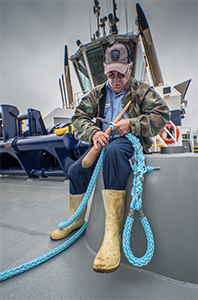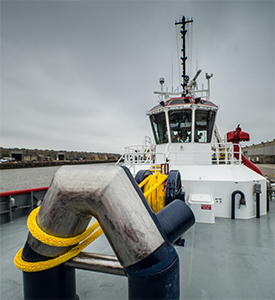Seabulk Towing turned heads in January 2017 when it welcomed Trident, the first U.S. Advanced Rotortug (ART), to its home base in Ft. Lauderdale, Fla.
In March 2018, Trident’s sister ARTs, Triton and Trinity, gave Mobile Bay tugboat watchers a treat, churning all three z-drives and propelling a water dance of omnidirectional moves.
Trinity was delivered in February, and since then has served Seabulk’s Mobile, Ala., customers. A month later, Triton was in Mobile for trials and crew training before heading to Port Arthur, Texas.
“The best way to describe the Rotortug would be as the next-generation SDM (Ship Docking Module),” said Rick Groen, Seabulk vice president and Seacor Ocean Transport vice president of operations. Seabulk is a subsidiary of Seacor Holdings.
 |
|
Capt. Bryan Welch helming Triton. |
“Even though the Rotortug was not invented nor designed by us, it is the logical next step of improvement from the SDM,” Groen continued.
SDMs are highly maneuverable tugs with fore and aft drives mounted on opposite sides of the centerline. Seabulk operates five such vessels. Rotortugs add power and propulsion redundancy, with two z-drives forward and one aft.
The ability to work LNG terminals was a prime motivator for building the ARTs. “We have a tremendous track record and want to expand on that by being an experienced Rotortug operator,” Groen said. “We feel very strongly the Rotortug is the ideal assist tug for terminals in general and LNG terminals in particular.”
Robert Allan Ltd. of Vancouver, B.C., introduced several refinements to the Rotortug design while working with Kotug, the Dutch company that developed the vessels in the late 90s. Robert Allan later became the exclusive worldwide ART designer.
 |
|
Seabulk Towing crew posing aboard Trinity: from left, Captains Mike Wilson, Welch and Steve Rotert, and chief engineers Buck Shoemaker, Richard Johnson and deck hand Kenny Bolin. |
These tugs are typically defined by their bollard pull and length, with the suffix “US” added to the American boats. As such, Seabulk’s 98.5-foot tugs with 80-ton bollard pull are designated ART 80-98US. They were built at Master Boat Builders, of Bayou La Batre, Ala.
“We liked the vessel redundancy the design provided — the additional drive unit so if one breaks down you’re not incapacitated, and the ability to run the boat as an ASD, true tractor (tug) or SDM,” said Groen. “We could lose a drive unit and still continue with the two units still functioning and have a bollard pull of 51 tons.”
The lead boat in the series, Trident, has proven itself during the last 14 months in Port Everglades, said Capt. Mike Wilson. He and Capt. Steve Rotert, armed with a boatload of experience on Trident, helped train the new tugs’ captains and crew in Mobile.
During a recent visit, Capt. Bryan Welch from Port Arthur was completing his second training day on Triton. Welch has extensive experience with ASD tugs, notably the 5,300-hp Apollo in Port Arthur. “These tugs are definitely different to operate,” he said. “They are a lot more maneuverable than the ASDs.”
 |
|
Triton’s remote-controlled FFS fire monitor is capable of 5,240 gpm. |
Rotert acknowledged ARTs can take some getting used to. “But once you learn how to operate the third engine, it picks up quickly,” he said.
On a typical ASD or tractor tug, a skeg provides the hydrodynamic force used to steer a ship. But on a Rotortug, the third thruster positioned aft provides for the same forces, Rotert explained. Not having a skeg increases maneuverability and makes for safer escorting as well. It also allows for more control in a ship’s wake or bow wash.
“If you lose any propulsion, the tug will simply fall in behind the ship and avoid tripping,” Rotert said.
The ART 80-98US has a fore and aft speed of 12.5 knots, slips sideways at 8.5 knots and can turn on a dime. The increased mobility and maneuverability provided by the third drive lets the tug shift position easily when ship handling under load in tight spaces.
 |
|
JonRie supplied winches for Triton and its sister tug Trinity, shown off the bow. |
The “rotoring” maneuver is another advantage when handling longer ships. With this move, the tug operates within a vessel’s beam limits. In the rotoring mode, the tug’s wash is directed away from the ship, allowing for more efficient control.
A notch on the joystick allows the clutch to be slipped on the drive engines between 0 and 125 rpm. Past 125 rpm, the clutches kick back up to 1,600 rpm. “We use it anywhere we don’t want to create a turbulent wheel wash,” said Rotert. “In tight slips or docking, wherever a strong wheel wash would push against a hull or dock and work against the tug.”
As for slow docking, Wilson said: “You slip-clutch the port engine and work in SDM mode.”
Three Caterpillar 3512C Tier 3 diesel engines producing 1,911 bhp at 1,600 rpm provide propulsion on Trident and Triton. The engines are coupled with Schottel SRP 1012 z-drives. Twin Caterpillar 150-kW gensets provide electrical power.
 |
|
Triton is powered by three Cat 3512C engines each producing 1,911 hp. |
When Seacor introduced Rotortugs into its fleet, the company planned to add a stern drive to Eagle, a forward tractor tug based in Port Canaveral. “It ended up that converting to a Rotortug was almost as expensive as building new,” Groen said, “so we kept the engines and drives in storage, and then later decided to build a new one with the equipment.”
As such, Trinity’s propulsion is a little different than its sister tugs. Its powertrain consists of Tier 3 Caterpillar 3512C mains generating 1,649 bhp and turning Veth z-drives. The two auxiliary generators are 99-kW John Deeres.
Trident’s wheelhouse, designed for maximum all-around visibility, provides a full and clear view of the tug’s fore and aft working areas. The helmsman sits amid a sophisticated array of hardware and electronics populating the molded Alphatron Marine integrated bridge system. The console monitors can be configured independently according to the helmsman’s preference. Displays feature touch-screen control for lights, whistle, horn, monitor displays and other functions.
As on Trident, Triton is outfitted with a JonRie Tri-Winch set. The term refers to a JonRie Series 230 hawser winch on the bow and a JonRie Series 500 double-drum winch on the stern. The stern winch towing drum is wound with 2,100 feet of 2.25-inch wire rope and the aft hawser drum holds the same cordage as the bow winch.
 |
|
Deck hand Kenny Bolin splices a loop into mooring line aboard the Rotortug Triton. |
The Tri-Winch configuration was designed for escort operation over the bow or stern and long-line towing over the stern. “It makes the winch set ideal for escorting, terminal support, towing and ship assist of the new containerships that come through the new Panama Canal expansion,” said JonRie President Brandon Durar.
The bow winch on Trinity is as described above. However, the stern winch on Trinity is a single-drum aft hawser winch. It is the first hawser winch designed and built by JonRie with an independent gypsy head, providing versatility for aft deck operations. The main drum can be used to hold a load while the gypsy can be used simultaneously as an arm to move a second line.
The wide beam of the ART allows for generous living areas. The master’s and chief engineer’s cabins are in the deckhouse above two double crew cabins on the lower accommodation deck. The deckhouse also has a fully appointed mess-lounge and galley.
“These are the best boats I’ve ever been on, including the Voith Schneider-powered tugs,” Wilson said. “They compare to the Voiths for maneuverability but they have much more power. And a lot more thought in the design is paid to crew comfort: multiple heads — four of them — and everyone has their own room, a place to relax.”
 |
|
Seabulk Towing assigned Triton to Port Arthur, Texas, while Trinity works in Mobile, Ala. The lead tug in the class, Trident, operates from Port Everglades in Fort Lauderdale, Fla. |
When SDMs were introduced, they were much talked about, as are ARTs in the U.S. now. Although new to U.S. harbors, ARTs have proven their worth worldwide. With three now working on U.S. shores, there is a sense these tugs are gaining wider acceptance.
“Five years ago, maybe we built two or three Rotortugs a year,” said Mike Fitzpatrick, Robert Allan Ltd. president. “I think right now we have 14 that were either just recently delivered or under construction.”
“The market in general has accepted there are definitely some advantages of Rotortugs,” he continued. “You can see that now by the number that are being built.”

